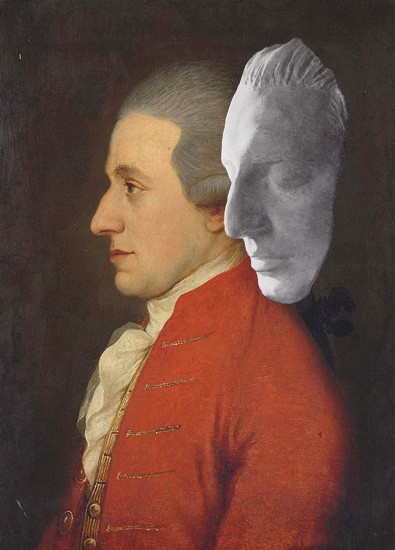Archive for April, 2009
 The face of Mozart, the composer ?
The face of Mozart, the composer ?
It has been recorded that Mozart’s death mask was made by Count Josef Deym von Stritetz on December 5, 1791 shortly after Mozart’s death on that day.
Like all such masks of its time, Mozart’s death mask was likely made of gypsum. Neither the original, nor a copy reportedly made for Contstanze Mozart survives. The death mask in this photograph is reported to be an unauthenticated bronze copy which was discovered in 1947. It is on display within Mozart’s home in Vienna, Austria.
Then there is the controversy over Mozart’s death mask. According to legend, Count Joseph Deym von Stritetz made a
plaster cast of Mozart’s face upon his death and subsequently exhibited the death mask in his gallery/museum, placed on a
wax figure dressed in fancy clothing. When the Count died in 1804, the mask went to his widow and upon her death in
1821 it vanished. Then, in 1947, a death mask turned up in an antique shop in Austria and ended up in the ownership of a
sculptor named Willy Kauer who, thinking it looked like Mozart, tried to get the Austrian Ministry of Education to
commission an inquiry in 1948 as to its authenticity. Although the mask had several features in common with Mozart,
including pox marks, they released their findings as inconclusive in 1949.
There was another investigation in 1950 and this time they decided that the mask was unlikely
to be Mozart’s and it was returned to Kauer. By 1956, the Mozarteum sponsored yet another
examination of it and studied two initials inside it seemingly from a bronze caster in Vienna
who worked during Mozart’s life named Thaddaus Ribola. He had a studio next to Count
Deym’s gallery during the 1790’s. Still, not enough evidence to be sure.
 Lizzie Borden took an axe….
Lizzie Borden took an axe….
Borden, Lizzie (1860-1927), accused murderer, who allegedly killed her father and stepmother with an ax in Fall River, Massachusetts, in 1892. Lizzie was the youngest child born to Andrew and Sarah Borden. Lizzie’s father, a banker, was one of the richest people in Fall River. When Lizzie was two years old, her mother died; her father’s second marriage a few years later supposedly caused dissension within the family over matters of inheritance and because of the lower social status of his new wife’s family.
On August 4, 1892, the bloody corpses of Andrew Borden and his wife were found in their home. Lizzie’s stepmother had been killed by 19 blows to the head, and her father had died of similar injuries. Within a week, police arrested Lizzie Borden for the crime, but she was acquitted after a sensational murder trial. In spite of the acquittal, the community of Fall River shunned Lizzie for the rest of her life. Lizzie’s actions, particularly her burning of a blood-stained dress in the kitchen stove a few days after the murders, led many to believe that she was guilty of murdering her parents. Lizzie and her surviving sister split their inheritance. The sisters died within a few days of each other in June 1927.
Lizzie Borden took an axeAnd gave her mother forty whacks.
And when she saw what she had done
She gave her father forty-one.
 Goodbye, my friend, goodbye….
Goodbye, my friend, goodbye….
Sergei Yesenin, the son of Russian peasants, was born in Kronstantinovo on 21st September, 1895. When he was seventeen he moved to Moscow as a young man and worked as a proof-reader.
Yesenin began writing poetry and was a great admirer of Alexander Blok. Yesenin’s first volume of poetry, Ritual for the Dead, was published in 1916.
He supported the October Revolution as he believed it would provide a better life for the peasantry. This was reflected in his volume of poems, Otherland (1918). He soon became disillusioned and began to criticize the Bolshevik government and wrote poems such as The Stern October Has Deceived Me.
In 1922 Yesenin married the dancer Isadora Duncan and accompanied her on a tour of Europe. Often drunk, his smashing up of hotel rooms, received a great deal of publicity in the world’s press.
Yesenin returned to his homeland in 1923 and published Tavern Moscow (1924), Confessions of a Hooligan (1924), Desolate and Pale Moonlight (1925) and The Black Man (1925).
Sergei Yesenin suffered a mental breakdown and was hospitalized. Yesenin was released and on 27th December, 1925, he cut his wrists, wrote a farewell poem in his own blood (goodbye, my friend, goodbye), and then hanged himself. Although one of Russia’s most popular poets, much of his work was banned during the rule of Joseph Stalin. His complete works were republished in 1966.
The farewell poem:
Goodbye, my friend, goodbye
My love, you are in my heart.
It was preordained we should part
And be reunited by and by.
Goodbye: no handshake to endure.
Let’s have no sadness — furrowed brow.
There’s nothing new in dying now
Though living is no newer.







